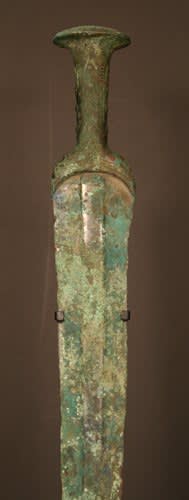Bronze Luristan Sword, 700 BCE - 500 BCE
Bronze
22.75
AR.006
Further images
The Luristan bronzes are probably the best known products of the craftsmen of ancient Persia. The majority of the objects are either horse-bits or ceremonial weapons. The present sword is...
The Luristan bronzes are probably the best known products of the craftsmen of ancient Persia. The majority of the objects are either horse-bits or ceremonial weapons. The present sword is a marvelous product of a culture adept in bronze working, created during the time of the early European Iron Age. The hilt of the weapon is incised with various designs and the pommel and hilt are all of one piece with the blade. Such an item would have been the prized possession of a wealthy warrior or even a chieftain, and the cost to fashion it would preclude ownership by the average inhabitant.
The area from which the bronzes are believed to come is centered on the modern provinces of Luristan in the western part of Iran. This region is mountainous, intersected by many ranges running in a north-west/south-east direction; between them, are well-watered plains, ideal for breeding horses. In antiquity access to the region was difficult; such remoteness must have encouraged its cultural isolation and idiosyncratic artistic production. From the archaeological excavations undertaken in the area, the prevalence of horse-related objects such as trappings and horse-bits would strongly indicate a society based on horsemanship, and possibly semi-sedentary in nature: a characteristic still present among the Lurs of today.
The area from which the bronzes are believed to come is centered on the modern provinces of Luristan in the western part of Iran. This region is mountainous, intersected by many ranges running in a north-west/south-east direction; between them, are well-watered plains, ideal for breeding horses. In antiquity access to the region was difficult; such remoteness must have encouraged its cultural isolation and idiosyncratic artistic production. From the archaeological excavations undertaken in the area, the prevalence of horse-related objects such as trappings and horse-bits would strongly indicate a society based on horsemanship, and possibly semi-sedentary in nature: a characteristic still present among the Lurs of today.









